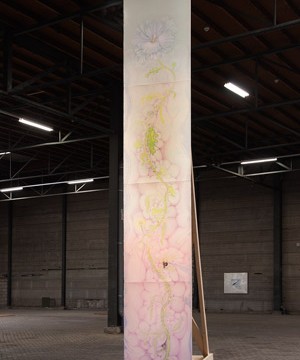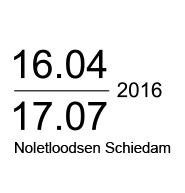kinke kooi
‘I am aware that I like to swim upstream,’ Kinke Kooi (Leeuwarden, 1961) says in an interview with Mirjam Westen. ‘Not out of rebellion, but because the sensation of resistance lends a form of support. People often speak of the importance of climbing the social ladder. No one talks about what it is to go in the opposite direction. That idea inspires me to create cavities to live in, seek shelter in, and in which to become part of a greater whole.’
In her drawings, she amplifies tiny subtleties to the point where viewing them becomes a haptic experience. In her work, she emancipates concepts such as pliability, bourgeois, the supportive nature of being stuck and hospitality.
Kinke Kooi studied at the Academy of Visual Arts in Arnhem. Her work has been included in museum collections in The Netherlands (including Arnhem and Rotterdam) as well as the United States, where she has exhibited regularly since 1995.
Truths moving along
She was brought up with it: looking through things. Growing up in the sixties and seventies, so much was not obvious for girls. And she needed to develop an eye for that, so artist Kinke Kooi (1961) was taught by her mother. Her mother was her greatest source of inspiration: she audaciously emancipated herself, but with that same audacity, celebrated her homely existence and the care for her children.
From a young age, Kooi has done nothing but look through things, at the disregarded spaces in between. Visual holes that get brushed aside become the subjects of her extensive exploration. She magnifies that which is perceived to be useless, ugly or otherwise stupid. This leitmotiv twists its way like a pastel ribbon through Kooi’s life and — since she left the art academy in Arnhem – through her work. After the academy, it begins hesitantly. Retrospectively, yet with a clear signature.
During the eighties, Kooi paints landscapes that look alienating, despite the fact that they are chockfull. There are trees and animals, painted in such a way that they appear to have been jigsawn. The shapes evoke memories of nurseries, folkloric patterns embroidered onto valances over kitchen windows. Kooi injects a sense of near physicality into her landscapes. The trees and animals stand there as if they might be picked up, as if one is viewing the landscape with one’s fingers, in the way one explores one’s own cuts and scrapes or pimples — a combination of delight and disgust.
At the start of the nineties, the figurative landscapes disappear, making way for new ones: abstracted landscaped of the body, of fat rolls, soft folds, amiable, rounded shapes which are set down in meandering, brightly coloured ballpoint strokes, surrounding one single image at the centre of the sheet. That central image may be a hippo, a nursing woman with leaking breasts, but also a bare buttock with cellulite. Her work becomes both fuller and more concentrated. Her thematics meander ever closer to soft power, which celebrates female identity, ornament, home crafts and underarm hair and covers everything that is, as Kooi herself calls it, ‘truth moving along’.
‘Western culture,’ the artist explains, ‘is very focused on construction, on stripping down and on the manifestation of the self.’ Her aesthetics are aimed at that which surrounds things, that which is covered. This can be the flesh around your bones, moss on a tree trunk, the ornaments in an interior or a plant’s stalks.
Her latest work on paper — a six metre high painting on a wooden flat, welcoming visitors of the Noletloodsen from the ceiling — is, once again, a true ‘Kinke Kooi’. Hospitality, as the new work is titled, is discernible from afar, due to its graceful hand and overcrowded composition. Goethe’s adagium ‘in der Beschränkung zeigt sich der Meister’ — cherished by modernists in the twentieth century — is wholeheartedly disregarded by Kooi.
In Hospitality – the art of hospitality — a white anemone on a neon green stem coils its way up a lilac background. That background resembles a system of intestines and is built up of a swarm of hollow and spheric shapes out of beautiful pearl necklaces, carefully arranged alongside each other, forming an undulating and rhythmical work.
If Kooi’s drawings were able to make sound, they would whisper or hum softly — so I imagine. In the midst of this gentle turmoil, the artist has painted tiny scenes. The hairy and archetypal ‘wrong’ Mary Magdalene mingles with a randy bonobo, who in turn is being interviewed by a microphone. Elsewhere, a fragile flower wraps itself around a four-square, accompanied by the captions ‘Come on hold me’ and ‘Go away, I want to be independent’.
They are pin pricks, with which Kooi challenges the current norms of what constitutes a decent or indecent relationship, of independence and dependence. As a feminist, she still stands on her mother’s shoulders, she says. This influences what she does, even if it means doing the opposite of what her mother would have endeavoured to. Hospitality, for example, evokes a great deal of associations for the artist who describes herself as autonomous. In Hospitality she explores the meaning of the word. Does one need to sacrifice one’s identity in order to be hospitable? To be subservient without being submissive? Exert curiosity and yet be able to put aside one’s ego? Indeed, all of the above. Hospitality is an absolute art form, and in good hands with Kooi.


